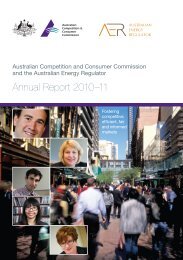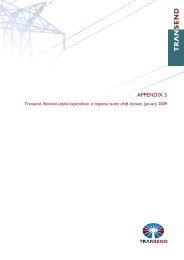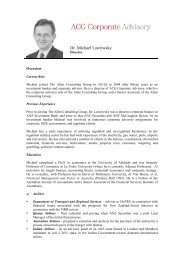Internal consistency of risk free rate and MRP in the CAPM
Internal consistency of risk free rate and MRP in the CAPM
Internal consistency of risk free rate and MRP in the CAPM
You also want an ePaper? Increase the reach of your titles
YUMPU automatically turns print PDFs into web optimized ePapers that Google loves.
171. Comb<strong>in</strong><strong>in</strong>g my best estimate <strong>of</strong> <strong>the</strong> historical average real required return on 10 year<br />
CGS with a beta <strong>of</strong> 0.8 <strong>and</strong> an <strong>MRP</strong> <strong>of</strong> 6.0% gives a real cost <strong>of</strong> equity <strong>of</strong> 8.20%. If<br />
expected <strong>in</strong>flation go<strong>in</strong>g forward is 2.50% <strong>the</strong>n a 5.99% nom<strong>in</strong>al CGS yield is required<br />
to deliver <strong>the</strong> same 3.40% real yield. Us<strong>in</strong>g this nom<strong>in</strong>al CGS yield with a beta <strong>of</strong> 0.8<br />
<strong>and</strong> an <strong>MRP</strong> <strong>of</strong> 6.0% gives a nom<strong>in</strong>al cost <strong>of</strong> equity <strong>of</strong> 10.78%.<br />
172. The 6.0% <strong>MRP</strong> estimate used above is <strong>the</strong> estimate most commonly used by<br />
Australian regulators over <strong>the</strong> period <strong>in</strong> relation to which <strong>the</strong> yields on CGS have been<br />
averaged. If <strong>the</strong> use <strong>of</strong> a 6.0% <strong>MRP</strong> over this period was, on average, correct <strong>the</strong>n it<br />
is consistent <strong>and</strong> appropriate that an average CGS yields over this period be added to<br />
it.<br />
173. While <strong>the</strong> genesis <strong>of</strong> <strong>the</strong> 6.0% <strong>MRP</strong> estimate may be based on <strong>the</strong> average <strong>of</strong> a longer<br />
time series <strong>of</strong> historical ex post returns on equity relative to CGS, I do not consider that<br />
this makes it problematic to use a shorter time series for historical average ex ante real<br />
return on CGS.<br />
174. There are two reasons why I hold this view:<br />
� Firstly, we are <strong>in</strong>terested <strong>in</strong> estimat<strong>in</strong>g <strong>the</strong> ex ante real <strong>risk</strong> <strong>free</strong> <strong>rate</strong> (i.e. <strong>the</strong><br />
expected return for <strong>in</strong>vestors after account<strong>in</strong>g for <strong>in</strong>flation). This can be estimated<br />
with much greater accuracy from <strong>the</strong> early 1990s onwards due to <strong>the</strong> <strong>in</strong>troduction<br />
<strong>of</strong> <strong>in</strong>flation <strong>in</strong>dexed bonds which allow us to directly estimate <strong>the</strong> real CGS yield<br />
actually required by <strong>in</strong>vestors over that period; <strong>and</strong><br />
� Secondly, <strong>and</strong> by contrast, historical average estimates <strong>of</strong> <strong>MRP</strong> must be based on<br />
very long time periods because <strong>the</strong> volatility <strong>in</strong> <strong>the</strong> observed ex post excess return<br />
on equities is so large that a long period is required <strong>in</strong> order to have any<br />
confidence <strong>in</strong> <strong>the</strong> average reflect<strong>in</strong>g ex ante <strong>in</strong>vestor expectations (ie, <strong>the</strong> excess<br />
return <strong>in</strong>vestors needed to expect <strong>in</strong> order to <strong>in</strong>vest). This is not <strong>the</strong> case with<br />
<strong>in</strong>dexed CGS where <strong>the</strong> promised real yield is <strong>the</strong> real yield actually delivered.<br />
Nor is it <strong>the</strong> case with nom<strong>in</strong>al CGS <strong>in</strong> a low <strong>and</strong> stable <strong>in</strong>flation environment such<br />
as has existed <strong>in</strong> <strong>the</strong> post 1993 period <strong>of</strong> <strong>in</strong>flation target<strong>in</strong>g by <strong>the</strong> RBA.<br />
7.3.1.2. Cross checks on <strong>the</strong> historical average cost <strong>of</strong> equity estimate<br />
175. An additional potential source <strong>of</strong> <strong>in</strong>formation on normal required returns for regulated<br />
bus<strong>in</strong>esses comes from US regulatory precedent <strong>in</strong>volv<strong>in</strong>g <strong>the</strong> application <strong>of</strong> <strong>the</strong> DGM<br />
model. For <strong>the</strong> US regulatory decisions from 2005 to 2011 described previously, I<br />
have estimated <strong>the</strong> average ROE is 10.38% (11.01% over <strong>the</strong> last 20 years). The<br />
average equity premium is 6.57% <strong>and</strong> average 10 year US Treasury <strong>rate</strong> is 3.80%.<br />
Note that this is based on DGM analysis performed by regulators. However, this is for<br />
an average gear<strong>in</strong>g <strong>of</strong> 47.98%. Adjust<strong>in</strong>g this to 60% gear<strong>in</strong>g gives an average cost<br />
<strong>of</strong> equity <strong>of</strong> 12.36%. 56<br />
56 12.36% = 3.805% + (1-0.4798)/(1-0.600)*6.575%<br />
Competition Economists Group<br />
www.CEG-AP.COM<br />
46







